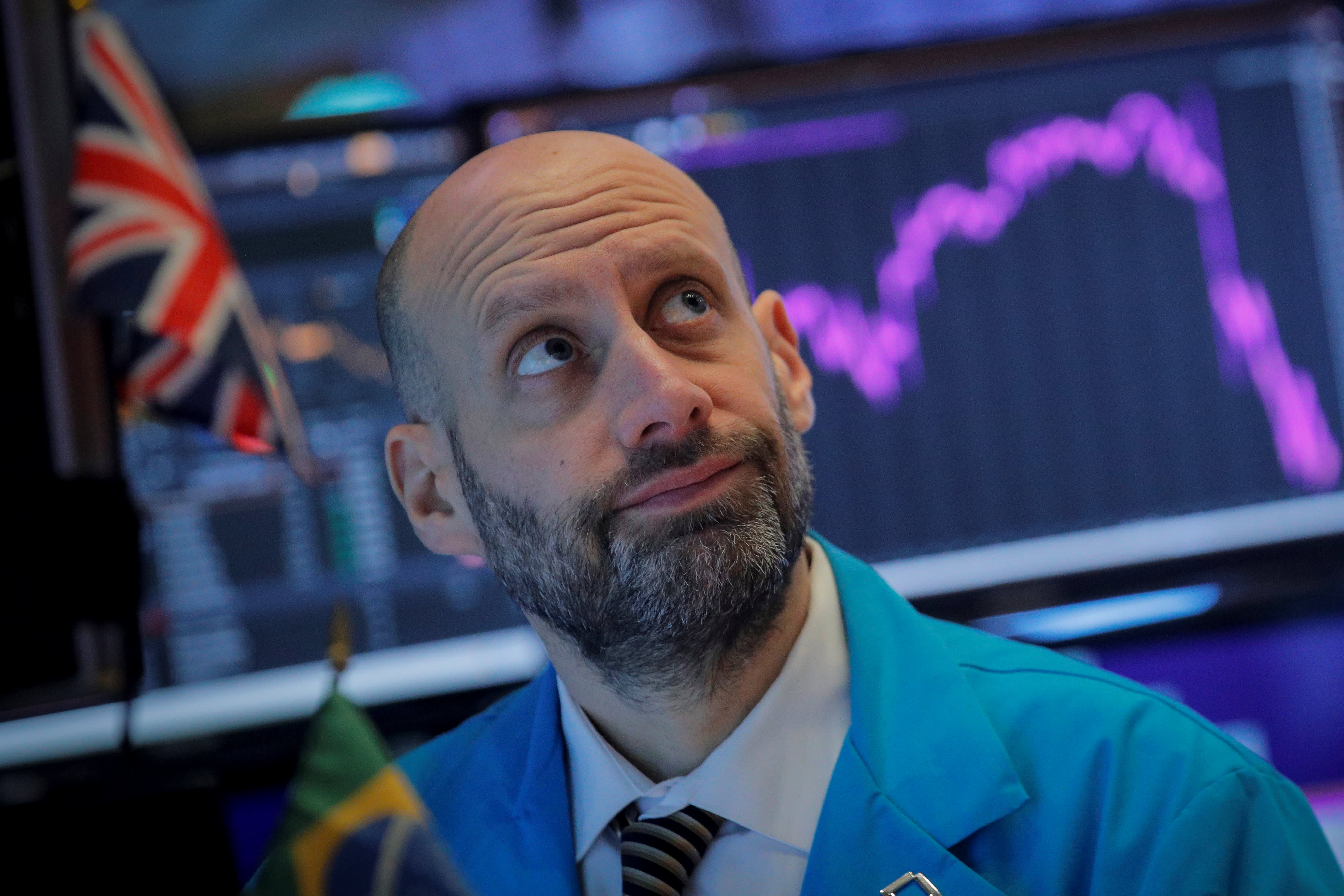A look at the state of the stock market one year since its pre-Covid peak
Traders work on the flooring at the New York Stock Exchange (NYSE) in New York, U.S., February 27, 2020.
Brendan McDermid | Reuters
For all the unprecedented occasions and unexpected penalties of the previous year, market circumstances right this moment rhyme quite intently with these of mid-February 2020, when shares peaked proper earlier than the Covid crash.
In the six months resulting in the Feb. 19, 2020, crest in the indexes, the S&P 500 had gained 15.8% to a collection of new all-time highs. Today, the index is up 15.9% the previous six months, and has been clicking to new information for many of that span.
Much of the discuss round the market is comparable, too: Worries that an excessive amount of of the market is dominated by just a few enormous progress shares (the high 5 S&P shares have been 20% of the index then and are 22% right this moment) and that investor sentiment had maybe grown too complacent.
Then, as now, the S&P was at a 20-year excessive in phrases of valuation, the ahead value/earnings ratio then simply above 19 and now surpassing 22 – but for individuals who select to match fairness earnings yields to Treasury yields, the hole is fairly shut: 3.7 share factors then versus 3.3 now.
The unfold on high-yield bonds has made an almost-perfect spherical journey in the previous year, sitting proper at excessive lows, which inserts into a way that beneficiant credit score markets are lubricating the economic system and markets.
Here’s how this equity-asset assist from forgiving debt capital markets was characterized in this column one year ago this weekend:
“Real investment-grade corporate bond yields are scarcely above zero. The Chicago Fed National Financial Conditions Index shows the liquidity backdrop is as loose as it’s been this cycle…A clear majority of S&P 500 stocks have dividend yields exceeding the 10-year Treasury yield. While no perfect relative-value indicator, this tends to provide a buffer underneath equity valuation.”
All of that’s true right this moment as nicely. And so is the fevered shopping for in a clutch of costly “story stocks” which excites youthful and more-aggressive buyers whereas making the traditionalists a bit nervous.
A year in the past: “A cluster of what might be called ‘idiosyncratic speculative-growth’ stocks are also acting quite frisky this year, a sign that investors are grasping aggressively for the next big thing (or perhaps just the next quick buck). ” Then it was Tesla, Beyond Meat and Virgin Galactic. Today it’s several-dozen names from GameStop to Canadian hashish to gasoline cells to early-stage fintech apps.
What’s completely different now
So, the echoes are fairly clear as this anniversary approaches. The variations, although, are a number of, necessary and make the present market extra dynamic in methods each favorable and – doubtlessly, ultimately – hazardous.
Let’s be clear that noting the related market set-up now isn’t remotely to foretell something like a repeat of the market collapse and financial calamity that started to unfold in late February of final year. The coronavirus unfold was a real exterior shock, the pressured world financial halt a primary, the five-week-35% freefall unprecedented.
Which brings us to some of the extra essential variations between now and a year in the past. The collapse reset the clock on the financial cycle and coverage stances. From 2019 into 2020 Wall Street was caught in a late-cycle vigil, with the economic system close to peak employment, the Treasury yield curve flat, company revenue margins close to peak, earnings projected to be flat.
The Fed was on maintain indefinitely in February 2020 with quick charges at 1.5-1.75%, however a big minority of Fed officers was projecting a fee hike in 2021.
The flash recession and revenue collapse prompted some $5 trillion in deficit-financed fiscal assist with extra doubtless, and turned the Fed most straightforward for a very long time to return, intent on ready for a return to full employment and a long-lasting rise in inflation earlier than making any tightening strikes.
So, sure, valuations are increased now and investor expectations could possibly be rising unrealistic.
But Corporate America refinanced itself for years to return at invitingly low charges towards a Fed backstop, earnings will probably be again above their prior peak this year, authorities is keen to run the economic system scorching and (arguably) coverage makers simply executed a repeatable course of for short-circuiting a recession.
Smaller buyers rush in
Another means that issues have modified in a year is the headlong rush of smaller buyers into the market, feeling invincible after making it by way of the crash and driving a near-80% rebound in the S&P 500.
Investors’ willingness to gorge on leveraged upside bets in the kind of name choices in unprecedented volumes and the on the spot mark-up of new IPOs comparable to DoorDash, Snowflake and AirBNB to multi-tens-of-billions in market worth at towering income multiples reveals a brand new extra aggressive and risk-tolerant ethos to the tape.
Some of this vitality was already beginning to movement a year in the past, nevertheless it hadn’t gained practically as a lot momentum or taken on as a lot of a viral character. The Russell Micro-Cap Index is up 65% in 3 ½ months. Penny-stock volumes have quintupled over the identical interval. Overall trading volumes are surging even with the indexes rallying – the reverse of the typical sample and harkening again to the same sample from the late Nineteen Nineties. Equity inflows in the newest week set a brand new document.
Social-media stampedes took GameStop shares from $12 to $400 again to $52 the previous two months, after which ran Tilray from $18 to $63 again to $29 in two weeks. Meantime, volumes in staid S&P 500 ETFs has sunk towards multi-year lows, apparently not racy sufficient for the marginal purchaser.
That complete litany describing the untamed animal spirits coursing by way of Wall Street says each that this can be a highly effective and well-sponsored bull market and that dangers of a wild overshoot are constructing. Then once more, everyone seems to be conscious they’re constructing and have been sounding alarms for some time.
Bank of America indicator nearing promote territory
Does the proven fact that subsectors of Reddit shares and faddish green-energy performs get overblown after which punctured with out undermining the big-cap indexes say they are not harmful? Or is the proven fact that just a few days of headlong shopping for in small short-squeeze shares late final month triggered a fast 4% S&P 500 spill a warning that the erratic tremors cannot at all times be safely dissipated by way of the market’s basis?
A year in the past, Bank of America world strategist Michael Hartnett was telling buyers to maintain enjoying danger belongings “until investors grow more clearly ‘euphoric,’ which he expects will mark the moment of ‘peak positioning and peak liquidity.'” Hartnett is holding that very same vigil now, his Bull & Bear Indicator appropriately holding buyers concerned however inching as much as a contrarian Sell threshold (which has preceded corrections in the previous and was final hit in early 2018).
All of this goes again to the thought aired here in early January that 2021 presents as a novel mix of 2010 and 1999 – the first full year of a brand new bull market driving long-acting restoration forces, blended with the remaining year of a robust bull market that blasted by way of each upside goal and created ranges of extra that took a pair years to work off.
Interestingly, although, the core of the market captured by the S&P 500 is metabolizing this combination with a quite regular and well-behaved – one may even say boring – uptrend. At least for now.
Starting subsequent week, Mike Santoli’s columns will solely be obtainable on CNBC Pro.




